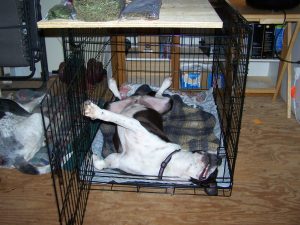
One of the things foster dogs do as they transition from crate training to house training is to get some supervised free-play time in the house. They still get time in the yard too, but we add house training to teach them to behave in a people house. There are more rules to house play than there are to yard play.
Roger has done well with his crate training. He rarely gets rowdy any more and he fusses only when he needs to go outside. He can go from the crate to the door and back without a leash, and he goes right in his crate to get his cookie. He has watched Blondie Bear and me being house dogs and has taken notes. He is still energetic, but more controlled. Sometimes he does play little games with Hairyface:
When Roger arrived here, he came with a treasured toy: Remington the Duck. A volunteer had given it to him while at the shelter. They told Hairy that Roger loved that toy so much that when they would go in to clean his run and dish up food, Roger would snatch up his duck and sit watching them with the toy clenched in his teeth, “This is my duck. You can take anything else, but not my duck.” So when they sent Roger here they sent Remington along with him.
Sometimes in free-play time they play “Retriever” (a.k.a. Fetch the Duck) and sometimes Roger just wants to play Duck-Slayer:
Even though it looks like he’s being really rough with it, the toy is perfectly intact. Roger will take our plush toys and try to rip them up (the Peoples stop him) but he never damages Remington.
These free-play times are getting longer as Roger learns to be self-controlled. He will always be energetic — that’s just Roger. But as he learns to behave well, and can show that his house-breaking is holding, he will get more and more time out of his crate. The goal is to get him to where he only goes to his crate when he wants to during the day and confined there only at night.

To those who think that crating a dog is cruel and unusual punishment: you could not be more wrong. If crate training is done properly, our crate is a safe-haven, a space all our own. I loved my crate while I was being house trained, and insisted on sleeping there for a long time afterward. Eventually I abandoned that for a snuggle bed, but I never viewed my crate as punishment. You have your bedroom, I had mine. That’s the way most of us feel.
Being comfortable in a crate, even if not used all the time, can also be a benefit to you if you decide to take us traveling with you. We may not be as welcome to run freely in a relatives home. If you leave us in a motel room while you go for breakfast, a crate will avoid any unfortunate surprises when you get back.
Roger does not think of his crate as punishment. He is delighted to come out and play, but when free-play time is over, he is just as willing to go back to his big blankie, his chew toys, Remington, and a cookie (for being a good boy). He knows if he fusses, he will be allowed to go outside, so it is not imprisonment. It’s just part of being a house dog.
| If you enjoy our updates, Doggy Tales, and educational articles consider subscribing for notices when new pieces are posted. It’s painless and you can unsubscribe any time you want. Your e-mail address is used ONLY to deliver these notices. | [email-subscribers namefield=”YES” desc=”” group=”Public”] |



